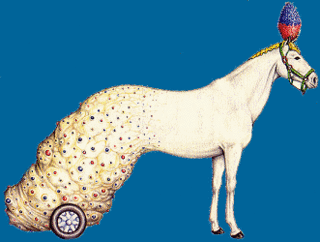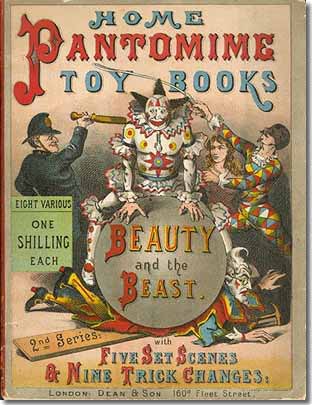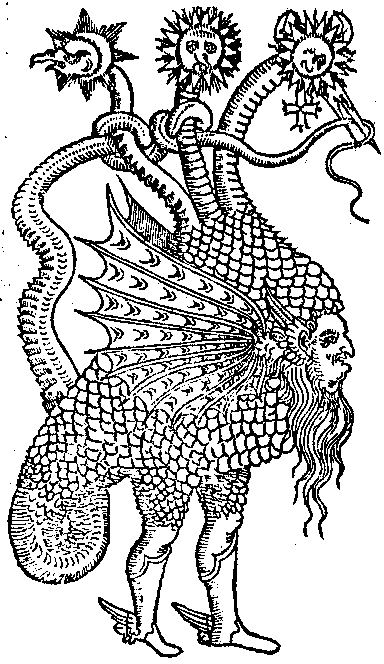
Emblem from A. Bocchi
Symbolicarum quaestionum.
Bologna, 1574
The JR Ritman Biblioteca Philosophica Hermetica in Amsterdam have an exhibition (with some scans) entitled Hermes Trismegistus - Pater Philosophorum. Modern evalutation divides the Hermetic texts into practical - alchemy, magic and astrology - and philosophical works.
In relation to the philosophical Hermetic texts......"The most important works amongst these are: the Latin Asclepius, the translation of which was for a long time wrongly attributed to Apuleius of Madaura (ca 123), the Corpus Hermeticum, fragments of Hermetic texts from the anthology of philosophical works, compiled by Johannes Stobaeus (ca 500), fragments from Lactantius, Cyrillus and others and Hermetic texts from the gnostic library of Nag Hammadi, including Coptic fragments of the Asclepius and the Hermetic definitions (cf Mahé)."
Saturday, September 17, 2005
Corpus Hermeticum
Romanian Religious Works
 Liturghierul lui Macarie (slavonă), 1508
Liturghierul lui Macarie (slavonă), 1508 Pop-Up Books
- Pop-up/moveable book exhibition at University of North Texas
- Pop-up books: how to
- Robert Sabuda home
- A review of Sabuda's work (published today - copied in as a comment)
- Google images pop-ups
Perry Visits Japan
 Landing of Commodore Perry, Officers & Men of the Squadron to meet the Imperial commissioners at Simoda, Japan, June 8th, 1854
Landing of Commodore Perry, Officers & Men of the Squadron to meet the Imperial commissioners at Simoda, Japan, June 8th, 1854
Wilhelm Heine 1855-1856
Elephant folio lithograph
This painting belongs to one of 3 sets of artistic works that all record the first official contact between Japan and America. A set of anonymous Japanese painted scrolls from the latter half of the 19th century and 3 Japanese broadside woodcut illustrations on tissue paper make up the visual display of the Perry Visits Japan exhibition at Brown University. Included are student essays and expedition diary accounts.
Woodcuts

Albrecht Dürer's celebrated, if fanciful, Rhinoceros commemorates the arrival of a live animal at Lisbon in 1515.
More Dürer illustrations at the British Museum and also particularly at Connecticut College.
A Heavenly Craft - The Woodcut in Early Printed Books exhibition at The Library of Congress.
What is a Print? exhibition at the Museum of Modern Art (flash).
Friday, September 16, 2005
St Gallen Abbey Library Manuscripts
 The St Gallen Abbey itself was founded in the 8th century and was used as a religious institution for a thousand years. It is listed as a World Heritage site and is run by the Catholic church and the library is still in use. The baroque interiors are breathtaking from the pictures that are around.
The St Gallen Abbey itself was founded in the 8th century and was used as a religious institution for a thousand years. It is listed as a World Heritage site and is run by the Catholic church and the library is still in use. The baroque interiors are breathtaking from the pictures that are around.Thursday, September 15, 2005
Female Scientific Illustrators


Womens Work is an exhibition at the Linda Hall Library of Science, Engineering & Technology that features the works and portraits of a dozen scientific illustrators from the 17th to the 21st century.
________________
Bookbinding - Bibliopegia

William Shaw Cathcart
Disputatio Juridica
Edinburgh: 1776
British Bookbinding 16th-19th century
University of Glasgow Special Collections
Wednesday, September 14, 2005
Some Terminology
 Papyrus: A wetland variety of sedge, Cyperus papyrus was once widespread around the Nile delta. From about 3000 B.C. papyrus began replacing stone tablets as a writing medium. Slices of the plant stem were arranged in perpendicular layers and pressed together with makeshift glue. The word paper is derived from papyrus via a Greek adaptation of the name. Extraordinary examples include the Elephantine papyri and the famous finds at Oxyrhynchus and Nag Hammadi. Normally they were made as scrolls as opposed to book-sized documents. Exported papyri often faired poorly as they deteriorate with mould growth in non-arid areas.
Papyrus: A wetland variety of sedge, Cyperus papyrus was once widespread around the Nile delta. From about 3000 B.C. papyrus began replacing stone tablets as a writing medium. Slices of the plant stem were arranged in perpendicular layers and pressed together with makeshift glue. The word paper is derived from papyrus via a Greek adaptation of the name. Extraordinary examples include the Elephantine papyri and the famous finds at Oxyrhynchus and Nag Hammadi. Normally they were made as scrolls as opposed to book-sized documents. Exported papyri often faired poorly as they deteriorate with mould growth in non-arid areas. Parchment: The untanned hides of sheep, goats and calves were prepared for dual sided writing by removing hair and applying lime and gradually came to replace papyrus. First used around the 5th to the 2nd century B.C. its heyday was during the middle ages. Vellum is a finer type of parchment (rubbed with pumice) and more precisely refers to parchment made from calf hide but the terms are generally interchangeable.
Parchment: The untanned hides of sheep, goats and calves were prepared for dual sided writing by removing hair and applying lime and gradually came to replace papyrus. First used around the 5th to the 2nd century B.C. its heyday was during the middle ages. Vellum is a finer type of parchment (rubbed with pumice) and more precisely refers to parchment made from calf hide but the terms are generally interchangeable.
Codex: [Latin for book (codices or codexes pl.)] Used first around the beginning of the 2nd century A.D. it refers to handwritten works in bookform which came to replace the scroll as a writing format. It was still used in the early middle ages and the codex name designation is more generally applied, as with papyrus, to particular works from specific holdings eg. Codex Leicester, Codex Vaticanus and Aleppo Codex.
Paleography: The study of ancient and medieval manuscripts, independent of the language -- codicology, or the study of codexes is really subsumed within the paleographic definition. They are particularly schooled in transcribing often abbreviated primary works into modern editions. The expense and relative rarity of vellum and parchment meant that shortened versions were often produced originally.
Philology: Simply, it is the study of ancient texts and languages. With the modern emergence of spoken language based linguistics, some aspects, for example comparative linguistics, have been removed from the wider definition of philology. There is also no clear-cut boundary between interpretetive elements of philology and hermeneutics, the branch of philosophy concerned with human understanding and interpretation of texts.
Middle Ages: The traditional view of history (Eurocentric) divides human eras into prehistory, classical antiquity, middle ages, renaissance, early and modern historical periods. The middle ages commenced in about the 5th century, with the fall of the western Roman Empire, up to about the 15th century, with the advent of the classical revival in Italy.
Codex Seraphinianus

Giornale Nuovo's misteraitch scanned some amazing images from a 1981 Italian book Codex Seraphinianus by Luigi Serafini.
It presents an alien world along with its own rosetta stone.
But the book is rare and prohibitively expensive for the common folk, like myself. More images here. Many more links to images and discussion of the book.
The Endeavour Botanical Illustrations
For some reason that was one of the few botanical names to stick in my mind from undergraduate biology. It has five leaf veins.
 Banksia serrata from the Proteaceae family
Banksia serrata from the Proteaceae family The voyage of HMS Endeavour took place between 1768 & 1771. It was arranged as a purely scientific undertaking. The Endeavour Botanical Illustrations is an exhibition at the British Natural History Museum and covers the South Pacific, New Zealand, Australia and parts of South America. The complete printing of the illustrations and engravings didn't finally occur until the 1980s - it took botanist Sir Joseph Banks 11 years of preparation in the 18th century and then another 10 years of modern processing to complete the task. They were ultimately published in a limited edition 3-volume set.
Tuesday, September 13, 2005
Lindisfarne Gospels Manuscript
The Lindisfarne gospels manuscript has somehow survived intact for 13 centuries. Bishop Eadfrith dedicated this masterpiece among illuminated manuscripts to the enshrining of St Cuthbert in about 710 A.D. It is part of the Cotton collection at the British Library.
 "Incipit page of the gospel of Luke {large jpg}, with interlace, spiral,
"Incipit page of the gospel of Luke {large jpg}, with interlace, spiral,and zoomorphic motifs. The cat whose head appears in
the bottom right-hand corner has eaten some birds, and
In addition to its intrinsic artistic worth in which sacred calligraphy is combined with intricate decoration, the manuscript is also historically important. The "native Celtic and Anglo-Saxon elements blend with Roman, Coptic and Eastern traditions to create a sublimely unified artistic vision of the cultural melting pot of Northumbria in the seventh and eighth centuries". It was thus part of the artistic body of works that helped define a sense of the evolving English national identity.
The Legend of St Eustachius - French Illuminations
It is refreshingly illuminated of 'the french' to have an english language version available for Le Moyen Âge en Lumière but I'm not so sure how illuminated it is to boil angelic children in a bovine pot.
[Don't get me wrong, I love all things french and have some sympathy for their stoic resistance to anglicizing the world, but until a really competent translator is available (yes, google I'm looking at you - you promised!) we generally miss out on a lot of information -- for those of us, like me, who must rely upon our distant schoolboy french.] But this is a wonderful site!
The Legend of St. Eustachius
In the 2nd century A.D. Roman general Placidius saw a vision of Jesus between a stag's horns and converted to christianity, changing his name at baptism. Thereafter he and his family were subjected to faith-testing calamities. Ultimately when he refused to engage in a pagan sacrifice, the emperor Hadrian condemned Eustace and his family to die by roasting inside the iron bull. Or so the oft'-depicted-in-the-middle-ages story goes.{The image is from the late 15th century}
The Golden Targe
Scot William Dunbar was court poet to James IV at the end of the 15th century. The Golden Targe is a richly decorative allegory in which Dunbar's caustic rhetoric was given full voice in depicting the conflict between love and reason. She is lustiar of chere and he puts up his scheld of gold so schene. Some commentary.
Monday, September 12, 2005
Hans Christian Andersen Danish Royal Collection
Hans Christian Andersen was born 200 years ago in Odense, Denmark. He is best remembered for his fairy tales --- Thumbelina, The Ugly Duckling, The Little Mermaid & The Emperor's New Clothes --- to name but a few. By all accounts, he was not happy being cast as a fairy tale writer. He tried his hand as a singer, dramatist, poet, novelist and travel writer. He was celebrated during his lifetime across Europe, moreso outside of his homeland and he ultimately spent some 9 years abroad. Charles Dickens, who saw Andersen off after his first visit to London, was said to have possibly modelled the obsequious character Uriah Heep from David Copperfield on Andersen.
Andersen was a product of two towns, Odense and Copenhagen and also of two ages. He grew up poor under a monarchy, was educated through royal patronage and was accepted by the upper classes once his fame was established. But throughout his works, Andersen projected a trust in the movement towards humanitarian attitudes and enlightenment. On the whole, Andersen's stories were dark and full of tension, moving between sensitivity and irony, wit and cruelty but even with a pessimisstic reading Andersen was a protagonist for human nature (gently suffused with a non-dogmatic religious belief) being a great measure of value especially in the artistic world.
Cyclopaedia

Somewhere between Pliny the Elder and wikipedia comes...
Ephraim Chambers: [1728]
"Cyclopaedia, or, An universal dictionary of arts and sciences : containing the definitions of the terms, and accounts of the things signify'd thereby, in the several arts, both liberal and mechanical, and the several sciences, human and divine : the figures, kinds, properties, productions, preparations, and uses, of things natural and artificial : the rise, progress, and state of things ecclesiastical, civil, military, and commercial : with the several systems, sects, opinions, &c : among philosophers, divines, mathematicians, physicians, antiquaries, criticks, &c : the whole intended as a course of antient and modern learning"





























